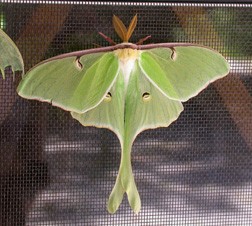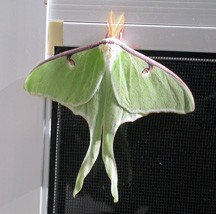Luna Moth
- Share
- Tweet
- Pin
- Share

A male Luna Moth with his wings extended clings to a door screen. Do you see the elephants facing each other?
Occasionally our front door outside light has been accidentally left on during the night, often resulting in a wonderful array of moths clinging to the screen on the door, the siding of our home or on the sidewalk. If we’re especially lucky one of the nighttime visitors will be a Luna Moth. Every sighting of this lovely pale jade-green creature is just as wonderful as the last.
I’ll always remember hiking in our woods years back with Charlotte and friends Ray and Barbara on Flag Day, Charlotte’s birthday. Barbara made an exciting discovery on the undersides of some American Beech leaves of a two-foot-tall sapling.
There, bodies united in mating posture, was a pair of Luna Moths. The male could easily be distinguished from the female by the greater width of his antennae. The delicate light green of their wings along with the extended tips hanging downward blended beautifully with the similarly colored Beech leaves. It took extremely sharp eyes to locate this welcome find.
The moths were apparently quite oblivious to my picture taking. Finally a slight unintentional movement of my hand against the twig and the female dropped to the ground while the male fluttered upward and away in his spectacular slow loping flight.
The four of us turned our attention to the female lying quietly on the ground, wings outspread to perfection. We marveled at the intricate colors of her eyespots, white abdomen, and the soft purple color bordering the leading edge of her front wings. My first thought, in an attempt to help the Luna (“Luna” in Latin refers to the moon.) was to return her to the Beech leaves. Several tries failed as she refused to grasp the twig and instead fluttered back to the ground. The thing that amazed me was her considerable weight due to the eggs, perhaps upward of 300 or more, she was carrying inside her extended abdomen.

The male Luna Moth can be identified by his wide antennae. Notice the purplish leading edges of his forewings.
Later our moth expert friend, Bill Sieker, informed us that had the pair not been finished mating they would have maintained close tight contact with each other. He added that the male would very likely continue his search for another female with which to mate, while she would lay her eggs and die with a few days. It was the wide feathery antennae of the male containing extremely sensitive sensory cells that enabled it to locate the female perhaps from several miles away. She had released pheromones from the tip of her abdomen, which provided the male, and very likely other male Lunas as well, with a target to seek. The life span of these amazing creatures is usually between one and two weeks, and there is very likely only one generation per year at our more northerly latitude.
Nature has provided this Luna, as well as other moth species, with a little sac called the spermatheca which is directly attached to the female’s reproductive system. Following mating the male’s sperm cells are stored in this container. In other words the eggs are not fertilized immediately upon mating.
We were told by people recently of seeing what they estimated to be about 30 Luna Moths clustered together at one site. A good guess might be that one female had attracted close to 30 male Lunas. I recall reading a story written by a naturalist who found a live female Luna Moth and released it inside his large enclosed screened porch. Later that night he went to the porch to check on the moth and found that her potent “perfume” had attracted a dozen or more male Luna Moths which, one by one, were being attacked and their abdomens eaten by a Screech Owl.

The eye spot on the rear wing of the Luna Moth.
The gorgeous little “eye spots” on the four wings of Luna Moths, also located on other giant silkworm moths including for example the Cecropia, Io, Polyphemus and Promethea, are designed in nature to confuse potential predators. Perhaps the noticeable eye spots might draw a predator’s attention toward them rather than the extremely important and more vulnerable abdomen. We couldn’t help but see, as we thoroughly admired the female’s outstretched wings, what appeared to be two sleepy-eyed Elephants facing each other.
People who have seen a Luna Moth fly (I’ve seen it only twice) claim that it has a spectacular and rather slow loping flight, exactly what you would expect from such a large heavy-bodied creature having such delicate wings. To this day, having lifted the female Luna so heavy with eggs, I wonder if the female can actually fly more than just short distances.
There is only one species in the Actias genus (pronounced AK-tee-us) in temperate North America and that’s Actias luna. There are other species in the Old World. Fortunately the Luna has an extensive range extending from Canada to Florida, westward to Texas and into the eastern parts of the Great Plains.
Luna caterpillars feed on the leaves of various trees, particularly the maples and birches in our region. They are also strongly attracted to hickory and walnut trees when they can find them where the females will lay their eggs on the undersides of the leaves. The larvae go through five instars, each lasting about one week, before cocooning. The cocoon is single-layered, partially wrapped in leaves, and falls to the ground when the tree sheds its leaves. There the cocoon will remain for the duration of the winter among the leaf litter. Unlike the cocoons of the Polyphemus and Promethea moths, which are relatively easy to find, those of the Luna are extremely difficult to locate.

A male Luna Moth in early morning sunlight.
When the adult moth ecloses (leaves its cocoon) it uses chitinous spurs, located near the bases of the front wings, to cut its way out of the cocoon. Naturally its wings will be very small upon closing, and it is imperative that the moth find a nearby twig or branch on which to climb. Now its wings will very slowly, over roughly a two-hour period, expand with fluid as they hang downward. Only then will the moth be capable of flight.
Too many of our wild creatures are being adversely affected by the actions of people today. Since moths in general are strongly attracted to light, there is concern that light pollution from man-made sources, especially sodium-vapor lights, may deter Lunas and other silk moths from mating and may have a negative impact on their populations in urban areas.
This is all the more reason for maintaining good wild places away from the city lights. Do all you can to “Keep Door County Wild!” Long live the Luna Moths!



